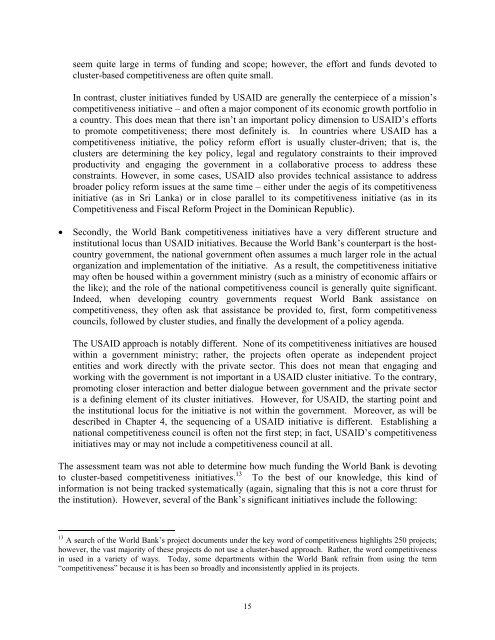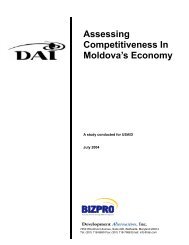Promoting Competitiveness in Practice - Economic Growth - usaid
Promoting Competitiveness in Practice - Economic Growth - usaid
Promoting Competitiveness in Practice - Economic Growth - usaid
Create successful ePaper yourself
Turn your PDF publications into a flip-book with our unique Google optimized e-Paper software.
seem quite large <strong>in</strong> terms of fund<strong>in</strong>g and scope; however, the effort and funds devoted to<br />
cluster-based competitiveness are often quite small.<br />
In contrast, cluster <strong>in</strong>itiatives funded by USAID are generally the centerpiece of a mission’s<br />
competitiveness <strong>in</strong>itiative – and often a major component of its economic growth portfolio <strong>in</strong><br />
a country. This does mean that there isn’t an important policy dimension to USAID’s efforts<br />
to promote competitiveness; there most def<strong>in</strong>itely is. In countries where USAID has a<br />
competitiveness <strong>in</strong>itiative, the policy reform effort is usually cluster-driven; that is, the<br />
clusters are determ<strong>in</strong><strong>in</strong>g the key policy, legal and regulatory constra<strong>in</strong>ts to their improved<br />
productivity and engag<strong>in</strong>g the government <strong>in</strong> a collaborative process to address these<br />
constra<strong>in</strong>ts. However, <strong>in</strong> some cases, USAID also provides technical assistance to address<br />
broader policy reform issues at the same time – either under the aegis of its competitiveness<br />
<strong>in</strong>itiative (as <strong>in</strong> Sri Lanka) or <strong>in</strong> close parallel to its competitiveness <strong>in</strong>itiative (as <strong>in</strong> its<br />
<strong>Competitiveness</strong> and Fiscal Reform Project <strong>in</strong> the Dom<strong>in</strong>ican Republic).<br />
• Secondly, the World Bank competitiveness <strong>in</strong>itiatives have a very different structure and<br />
<strong>in</strong>stitutional locus than USAID <strong>in</strong>itiatives. Because the World Bank’s counterpart is the hostcountry<br />
government, the national government often assumes a much larger role <strong>in</strong> the actual<br />
organization and implementation of the <strong>in</strong>itiative. As a result, the competitiveness <strong>in</strong>itiative<br />
may often be housed with<strong>in</strong> a government m<strong>in</strong>istry (such as a m<strong>in</strong>istry of economic affairs or<br />
the like); and the role of the national competitiveness council is generally quite significant.<br />
Indeed, when develop<strong>in</strong>g country governments request World Bank assistance on<br />
competitiveness, they often ask that assistance be provided to, first, form competitiveness<br />
councils, followed by cluster studies, and f<strong>in</strong>ally the development of a policy agenda.<br />
The USAID approach is notably different. None of its competitiveness <strong>in</strong>itiatives are housed<br />
with<strong>in</strong> a government m<strong>in</strong>istry; rather, the projects often operate as <strong>in</strong>dependent project<br />
entities and work directly with the private sector. This does not mean that engag<strong>in</strong>g and<br />
work<strong>in</strong>g with the government is not important <strong>in</strong> a USAID cluster <strong>in</strong>itiative. To the contrary,<br />
promot<strong>in</strong>g closer <strong>in</strong>teraction and better dialogue between government and the private sector<br />
is a def<strong>in</strong><strong>in</strong>g element of its cluster <strong>in</strong>itiatives. However, for USAID, the start<strong>in</strong>g po<strong>in</strong>t and<br />
the <strong>in</strong>stitutional locus for the <strong>in</strong>itiative is not with<strong>in</strong> the government. Moreover, as will be<br />
described <strong>in</strong> Chapter 4, the sequenc<strong>in</strong>g of a USAID <strong>in</strong>itiative is different. Establish<strong>in</strong>g a<br />
national competitiveness council is often not the first step; <strong>in</strong> fact, USAID’s competitiveness<br />
<strong>in</strong>itiatives may or may not <strong>in</strong>clude a competitiveness council at all.<br />
The assessment team was not able to determ<strong>in</strong>e how much fund<strong>in</strong>g the World Bank is devot<strong>in</strong>g<br />
to cluster-based competitiveness <strong>in</strong>itiatives. 13 To the best of our knowledge, this k<strong>in</strong>d of<br />
<strong>in</strong>formation is not be<strong>in</strong>g tracked systematically (aga<strong>in</strong>, signal<strong>in</strong>g that this is not a core thrust for<br />
the <strong>in</strong>stitution). However, several of the Bank’s significant <strong>in</strong>itiatives <strong>in</strong>clude the follow<strong>in</strong>g:<br />
13 A search of the World Bank’s project documents under the key word of competitiveness highlights 250 projects;<br />
however, the vast majority of these projects do not use a cluster-based approach. Rather, the word competitiveness<br />
<strong>in</strong> used <strong>in</strong> a variety of ways. Today, some departments with<strong>in</strong> the World Bank refra<strong>in</strong> from us<strong>in</strong>g the term<br />
“competitiveness” because it is has been so broadly and <strong>in</strong>consistently applied <strong>in</strong> its projects.<br />
15
















